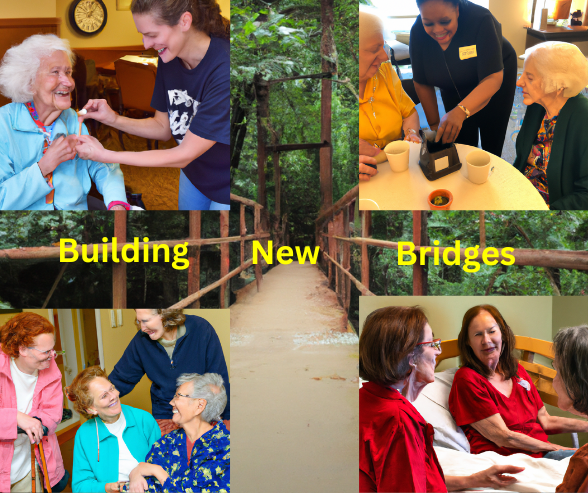The Real Impact of Well-Trained Volunteers
For the past thirty years, I have extolled the real, positive impact that well-trained volunteers have on a person’s quality of life and care in a long-term care community. But out of the 15,000 or so nursing homes in the United States, how many of them embrace a volunteer program as an integral part of the delivery of care to residents? There are many organizations formed to recruit and train volunteers for nursing homes, but the nursing industry continues to lag behind in embracing these valuable resources. Why is that? How can we turn the exception, the community that invests in volunteers, into the norm?
A Memorable Experience
Along this journey of mine, I have received numerous positive comments from residents about the volunteers I trained and placed in nursing homes. One notable experience I will always remember is the time I visited a woman living in a nursing home and an aide interjected to hand her a small paper cup with some pills in it. The aide encouraged the woman to take her pills. After taking the cup, the woman turned to me and said, “This is what they think I need; What you are doing for me right now, is what I need.”
The Need for Connection
That quote has stuck with me for years. She is exactly right! As humans, we need to know that we have some control over our lives, i.e., that we can make decisions for ourselves and feel some sense of independence. And perhaps even more importantly, humans need to feel connected. When we become disconnected from our friends, family, and community, and/or when we lose that sense of agency over ourselves, negative things happen: We may become depressed, sad, and even fearful; we may become angry or combative, start acting out, or become difficult to be with; we may even die prematurely. Studies show that when people are experiencing loneliness and isolation, they are twice as likely to die than those who are visited by family, friends, and, yes, volunteers. Yet, sadly, all too often the problem is medicated away, “These pills will make you feel better.”
Volunteers as a Remedy
Volunteers can serve as a powerful preventative to these tragic ailments, or as a remedy to them once they start to occur. It is time to start asking what the true antidote to a person’s sickness is. I argue that it is better to put people before pills in a long-term care strategy. We must prioritize training people to become companion volunteers so that residents feel that they are in control, capable of doing things, and in possession of meaningful relationships.
Research on Social Isolation and Loneliness
Research consistently shows that social isolation and loneliness are major risk factors for physical and mental health decline in long-term care residents. Volunteers can bridge the gap between clinical care and emotional well-being by offering companionship, engaging activities, and a listening ear. These human elements contribute significantly to a resident’s quality of life. They promote a sense of purpose, reduce feelings of isolation, and ultimately foster a healthier, more vibrant community within nursing homes. It’s time for leadership to recognize that the holistic care model—where emotional and social needs are as prioritized as medical needs—is essential for truly enhancing the lives of those in long-term care.
Volunteers and Care Staff Productivity
Volunteers are equally essential for increasing the productivity and satisfaction of care staff, as the social support that volunteers provide enables staff to complete clinical duties. I’ve observed and have had conversations with care staff about how they wish they had time to stop and chat with residents but that they realistically can’t. I’ve watched direct care workers run from one end of a nursing home to the other, trying to answer an overwhelming number of call lights. A great deal of those call lights were only pressed by residents because they felt alone and forgotten. Imagine how much more alone they would feel when they are answered by someone without the time to meet their social needs.
Companion volunteers eliminate these scenarios and free up staff to maximize the efficiency of their care. On top of this, volunteers can also positively impact how staff members feel about their job. Many have told me that when they see residents engaged in meaningful conversations with volunteers, the sight uplifts and inspires them. I think this goes a long way toward staff retention, which, needless to say, is an ever-present concern to most administrators. In that sense, volunteers not only help nursing homes holistically, through supporting residents and staff, but they also help materially.
Building Community Relationships
Yet even that is not the full scope of their value. A robust volunteer program can build a strong relationship between the nursing home it serves and the broader community. The critical importance of this function becomes clear when you consider how nursing homes are generally perceived. After all, what do people normally hear when the daily news broadcasts a story on nursing homes? It doesn’t seem very positive: deaths, abuse, fraudulent billing schemes… But when volunteers speak with their families, friends, and co-workers, they will likely have a completely different story to tell.
In fact, it has been my experience that when a prospective volunteer goes through meaningful, well-designed training that prepares them properly, they often go on to become a paid employee. One of the studies I’d like to conduct would find out just how many people working in this industry started off as volunteers. I don’t have an exact number for you as of now but based on the show of hands when I ask this question during presentations, I would estimate it as at least “a lot”! In talking with my colleagues, some of whom have gone on to become brilliant care providers, administrators, professors, and researchers in the field of aging, I am amazed at the stories they share—of how they were inspired and deeply moved by what they experienced to the point they were compelled to pursue careers in long-term care.
The Cost of Not Having a Volunteer Program
But, okay, I can hear some of you getting to this point and asking, “well, how much will this cost me?” Strong volunteer programs are conduits for attracting new employees, keeping old employees, and improving public perception, but costs are still costs. Let me respond by asking you another question, “How much is it costing you to not ramp up your volunteer program?” Are you fully staffed? Does your staff feel valued? What is your image like? Consider high turnover, burnout, absenteeism, and client wariness to be the costs you are accruing without a robust volunteer program. But with that program will come the human connection, efficiency, and quality that people will view as desirable for their loved ones.
The Long-Term Investment
With that being said, investing in a volunteer program is not going to magically change things overnight. You have to enter with the mindset that you’re in it for the long haul. It’s going to take time to hire a director of volunteers that is well-trained in volunteer management, careful planning, and then ongoing support and evaluations. But in time, the investment will pay off. For me, I’ve come to see nursing homes as “libraries with living books”, filled with priceless treasures read by too few. The people I’ve met and the stories they’ve shared have shifted my paradigm on life. I came away from my initial experiences rethinking, and still do rethink to this day, how I spend my time and who I spend it with. I encourage the people in my sphere to join me. Again, I ask, “Can you afford to not invest in a volunteer program?”
It’s Time to Lead: Transform Lives with Volunteer Programs
Are you ready to revolutionize the care experience in your long-term care facility? By integrating a robust volunteer program, you can enhance the quality of life for your residents, boost staff productivity, and elevate your community’s reputation.
Partner with Us Today
Visit our website at NALTCV.org or email us at Info@NALTCV.org to learn how to implement a successful volunteer program in your community. Take the lead in providing holistic care that prioritizes human connection. Your commitment can make a lasting impact. Act now!
–
(This blog was edited by Amanda our newest member to the team!)




